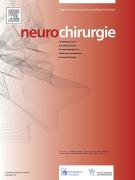Sagittal suture craniosynostosis or craniosynostoses? The heterogeneity of the most common premature fusion of the cranial sutures - 05/11/19
 , A. Gleizal, A. Szathmari, P.A. Beuriat, C. Paulus, C. Mottolese
, A. Gleizal, A. Szathmari, P.A. Beuriat, C. Paulus, C. Mottolese| pages | 7 |
| Iconographies | 3 |
| Vidéos | 0 |
| Autres | 0 |
Abstract |
Background |
Scaphocephaly is usually defined as the deformation of the skull resulting from the premature fusion of the sagittal suture. It is the most common type of craniosynostosis, and can be easily recognized on simple clinical examination. Its pathophysiology is easy to understand and to confirm on neuroradiological examination. In contrast, surgical indications are still somewhat controversial, the dispute mainly concerning therapeutic versus esthetic objectives. In recent years, however, several studies have challenged these basic and relatively simplistic interpretations of the pathophysiology of the condition.
Materials and methods |
To assess the heterogeneity of scaphocephaly, we reviewed cases of scaphocephaly operated on at the Hôpital Femme–Mère-Enfant, Lyon University Hospital, France during a 10-year period (2008–2017) and performed a review of the literature on scaphocephaly and sagittal suture closure.
Results |
During the 10-year period, 401 children were operated on for a scaphocephaly at the Hôpital Femme Mère Enfant, Lyon University Hospital. Mean age at surgery was 1.14 years, for a median 0.7 years (range, 4 months to 8. 5 years). Several subtypes could be distinguished according to morphology, intracranial findings on imaging, patient age, and etiology associated to the sagittal synostosis. Two main surgical techniques were used to correct the malformation, depending on patient age, type of deformation and the surgeon's preference: cranial vault remodeling with occipital pole widening, with the patient in a prone position, and parietal enlargement with or without forehead remodeling, in dorsal decubitus.
Conclusions |
The complexity and heterogeneous nature of sagittal synostoses depend on different pathogenic mechanisms leading to and interfering with the skull abnormalities: abnormalities of CSF dynamics, possibly associated with systemic alterations, accounting for the varied postoperative morphological and functional course, in terms of cognitive impairment and late complications (notably intra-cranial pressure elevation). However, the real impact of such heterogeneous clinical presentations on surgical indications and surgical results remains to be elucidated.
Le texte complet de cet article est disponible en PDF.Keywords : Sagittal suture, Non-syndromic synostosis, Single suture synostosis, Craniostenosis, Scaphocephaly
Plan
Vol 65 - N° 5
P. 232-238 - novembre 2019 Retour au numéroBienvenue sur EM-consulte, la référence des professionnels de santé.
L’accès au texte intégral de cet article nécessite un abonnement.
Bienvenue sur EM-consulte, la référence des professionnels de santé.
L’achat d’article à l’unité est indisponible à l’heure actuelle.
Déjà abonné à cette revue ?

